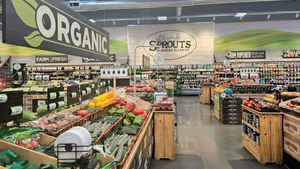A recipe for greater supermarket produce purchasingA recipe for greater supermarket produce purchasing
The use of fruits and vegetables as ingredients in dishes can boost sales
September 18, 2024

Retailers that are creative in highlighting unconventional uses of produce are in line to spur wider category interest and activity.
That includes getting shoppers to realize that fruits and vegetables can be valuable ingredients in recipes, said Maeve Webster, president of Menu Matters, an Arlington, Vt.-based food industry consulting firm.
Operators can spotlight the possibilities with eye-catching signage and by distributing detailed preparation data in produce departments and within specific produce displays, she said. That might include situating kiosks or other stations that enable shoppers to scroll through and print out recipes or forward the information to their smart phones, Webster said, and identifying the dishes or applications that are most appropriate for each type or variety of fruit or vegetable.
Such measures, along with conducting in-store cooking demos and samplings, can enhance the perception that the retailer is a produce expert, she said.
While most fruits and vegetables can be an ingredient in a recipe, the use of specific items will vary in accordance with such factors as cuisine, daypart, and meal part, Webster said.
“Every type of dish can benefit from produce,” she said, noting that fruits and vegetables also can enhance a recipe’s visual appeal by providing a wider array of colors and textures while increasing the “heft” of a dish without significantly boosting the cost or calorie count.
“Produce can augment the healthy halo of a dish or the actual nutrient density of a dish,” Webster said. “It creates intrigue when users apply various preparation techniques.”
Despite the greater sales opportunities from emphasizing produce as an ingredient, retailers still must alleviate shopper discomfort in preparing novel recipes if they are to maximize activity, he said.
“Many consumers don't have experience with different types of produce and are not sure how to use it, what to pair it with, and in what recipes it would work,” Webster said. “There is also the fear of wasting food and money if they were to purchase produce that goes bad before figuring out what to do with it.”
Shopper education is important as consumers also may not know how to select the right or ripe item or the ways to handle it following purchase, she said, which can include instructing how to peel objects correctly and pinpointing all edible parts.
“Additionally, there is a perception that money can be wasted on produce with pits or rinds if a fair share of it gets thrown out,” Webster said.
About the Author
You May Also Like


.webp?width=300&auto=webp&quality=80&disable=upscale)



